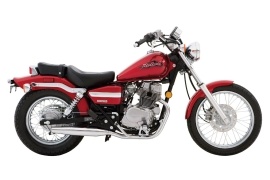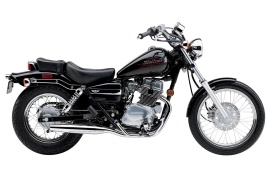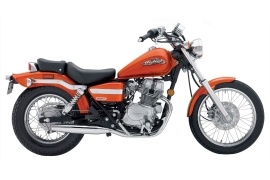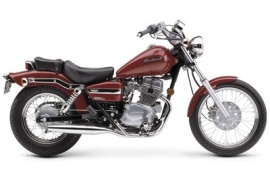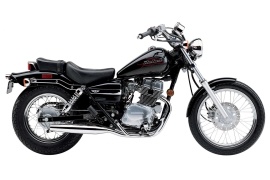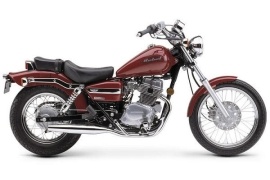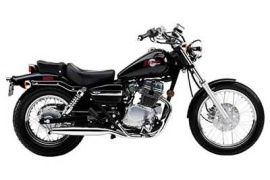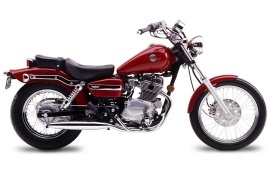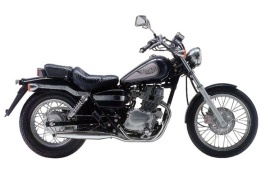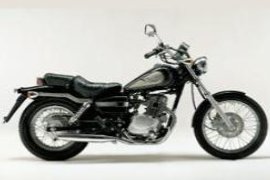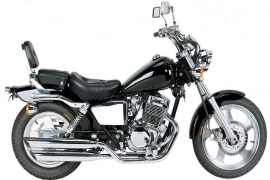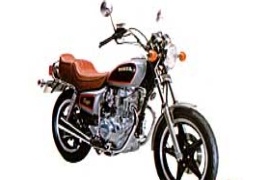HONDA CM Models/Series Timeline, Specifications & Photos
First production year: 1978
The Honda CMX250, also known as the Rebel 250 or the Honda Peronist, was a cruiser-style machine part of the CM series in Honda's range that included various models with different engine displacements, shapes, and sizes.
The first model, released in 1985, packed the same powerplant as the Honda Nighthawk 250 standard machine and was manufactured on and off between various periods.
The CMX250 was popular for young, new, or beginner riders, with its low seating position and cruiser capabilities. The bike was also commonly used as a learner's certified machine by the Motorcycle Safety Foundation.
In addition, the Metropolitan Police Department in Washington, DC, used the CMX250 as a replacement for their Vespa scooters. At the same time, in the mid-2000s, the CMX was replaced by the more powerful, reliable Harley Davidson XL883 Sportsters that offered more visibility.
In 2007, Honda launched the CMX250c Rebel, a cruiser machine with a lightweight and nimble package that offered smooth power delivery and a comfortable riding experience.
The bike's suspension was handled by a 33 mm fork on the front end in the suspension department. The rear end was held by dual shock absorbers with five-way spring preload adjustability.
The 2007 Honda CMX250c Rebel came with a new Candy Dark Red color that joined classic Black, but other than that was similar to the previous models. The 234cc engine still delivered 19 hp at 8,250 rpm and 19 Nm (14 lb-ft) of torque at 5,500 rpm.
The Honda CMX250 was a cruiser-style motorcycle part of the CM series that comprised models with different engine displacements, shapes, and sizes. The bike was also known as the Rebel 250 or the Honda Peronist.
The machine was powered by the same powerplant as the Honda Nighthawk 250 standard model and was manufactured on and off between 1985 to 1987, 1996 to 1997, and 1999 to 2016.
Over its production years, the bike didn't feature any significant modifications and packed the same suspension, braking system, and engine. Also, the model was commonly used by the Motorcycle Safety Foundation as a certified rider-training machine.
In 2006, Honda released the CMX250C Rebel, the smallest cruiser in Honda's range that delivered smooth engine performance and an excellent riding experience with its easy-shifting five-speed manual transmission.
The 2006 machine came in a new Pearl White color scheme. Besides that, the bike was similar to previous models, with a 33 mm fork handling the front suspension and dual shock absorbers operating the rear-end suspension.
Also, the bike was fitted with the same braking system as its predecessors, including a dual-piston caliper with a 240 mm disc on the front and a 230 mm rod-operated drum unit handling the rear-end suspension.
For power, the 2006 Honda CMX250C Rebel packed the same 234cc air-cooled parallel twin-cylinder engine as the previous models, delivering an output power of 19 hp with maximum strength at 8,250 rpm and 19 Nm (14 lb-ft) at 5,500 rpm.
The 2005 Honda CMX250C Rebel was a cruiser-style machine part of the CM series in Honda's range that included various displacement engines, shapes, and sizes. The bike was powered by the same engine as the Honda Nighthawk 250 standard model.
The 234cc four-stroke air-cooled parallel twin-cylinder engine delivered smooth power, with 19 hp on tap at 8,250 rpm and 19 Nm (14 lb-ft) torque at 5,500 rpm. It was fitted with an electric starter, screw-type valve adjusters, a constant velocity carburetor with excellent throttle response, and a solid-state CD ignition.
The bike was fitted with a semi-double-cradle steel frame with a long wheelbase and a low seat, a 33 mm telescopic fork handling the front suspension, and dual shock absorbers with five-position spring preload adjustability on the rear.
The braking power was carried from previous models, with a dual-piston caliper, a 240 mm disc bolted to the front wheel, and a rod-operated 230 mm drum braking unit on the rear for optimum stopping power.
In addition, the 2005 Honda CMX250C Rebel was fitted with many classic and custom elements, such as a two-piece custom-styled dual seat, a round headlight with a chromed housing, a chromed light housing, a simple instrument panel, chromed turn signal housings, and a pulled-back handlebar.
In the 1980s, the Honda CMX250 Rebel replaced Vespa scooters in the Metropolitan Police Department fleet in Washington, DC, until the police department chose the 2000 Harley-Davidson XL883 Sportsters with a more powerful engine and better durability and visibility.
In 1985, the Japanese maker brought into the cruiser market the CMX250, also known as the Rebel 250 or the Honda Peronist, set in motion by the same engine as the Honda Nighthawk 250 standard model.
The bike was manufactured on and off between 1985 to 1987, 1996 to 1997, and 1999 to 2016. It was the smallest cruiser machine in Honda's range, with a lightweight and nimble package, ideal for beginner and shorter riders.
In the 1980s, the Metropolitan Police Department fleet in Washington, DC, was replaced with the CMX250, until 2000, when it was swapt with the Harley-Davidson XL883 Sportster, which was better than the CMX250.
The 2004 Honda CMX250C Rebel was built on a semi-double-cradle steel frame adorned with classic elements, such as chrome-plated headlight and taillight housings, chromed turn signals housings, a simple instrument cluster, a two-piece custom seat, a chromed exhaust system, and wire-spoke wheels with chromed rims.
The braking system was carried over from the previous models, with a dual-piston caliper, a 240 mm disc on the front wheel, and dual shock absorbers on the rear with five-way spring preload adjustability.
Also, the 234cc parallel twin-cylinder air-cooled engine was carried from its predecessors with the same output power of 19 hp at 8,250 rpm and 19 Nm (14 lb-ft) of torque at 5,500 rpm.
In 2003, Honda released the CMX250 Rebel, an ideal entry-level cruiser machine with a lightweight and nimble package perfect for new or beginner riders with its low seating position.
When it was first launched in 1985, the bike was also known as the Rebel 250 or the Honda Peronist, powered by the same engine as the Honda Nighthawk 250 standard model. It was manufactured on and off for various years.
The Honda CMX was a popular choice for the Motorcycle Safety Foundation, which used it as a certified learners machine, and the Washington Metropolitan Police Department, which used it as a replacement for Vespa scooters.
The 2003 Honda CMX250 Rebel packed a semi-double-cradle steel frame with a long wheelbase and a low seating position, wire-spoke wheels with chromed rims, an o-ring sealed chain for more durability, a pulled-back handlebar, a 10-liter teardrop-shaped fuel tank, and a two-piece custom-styled seat.
The 2003 bike had the same suspension system as its predecessors, with a 33 mm telescopic fork handling the front wheel and dual shock absorbers with five-way spring preload adjustability on the rear.
Also, the braking system remained unchanged, with a dual-piston caliper and a 240 mm disc mounted on the front wheel, while on the rear, the stopping power was achieved by a rod-operated 240 mm drum unit.
With the same power on tap, the 2003 Honda CMX250 Rebel boasted 19 hp at 8,250 rpm and 19 Nm (14 lb-ft) torque at 5,500 rpm.
The CMX250 Rebel was the smallest cruiser-style machine in Honda's range, in a lightweight and agile package, making it the ideal entry-level cruiser for beginners and short riders due to its low seating position.
The bike debuted in 1985 and was known as the Reber 250 or Honda Peronist. It was manufactured on and off between 1985 to 1987, 1996 to 1997, and 1999 to 2016. It was powered by the same powerplant used on the Honda Nighthawk 250 standard machine.
In the 1980s, the CMX250 replaced Vespa scooters in the Metropolitan Police Department fleet in Washington, DC, until 2000, when it was replaced by the Harley-Davidson XL883 Sportster with more durability, visibility, and power.
The 2002 Honda CMX250 Rebel machine packed a custom, chrome-plated headlight case, chrome-plated taillight housing, chrome-finished turn signal housings, a simple instrument panel, a push-to cancel turn signal switch, and a maintenance-free battery.
The bike was released from the factory floor with standard features, including a round headlight, a chromed exhaust system, a two-piece dual seat, a teardrop-shaped fuel tank, and classic wire-spoke wheels.
The suspension was carried from the previous models, with a 33 mm telescopic fork cushioning the front wheel and five-way spring preload-adjustable dual shock absorbers handling the rear suspension.
In the power department, the 234cc parallel-twin air-cooled engine remained unchanged, boasting 19 hp at 8,250 rpm and 19 Nm (14 lb-ft) torque at 5,500 rpm.
In 2001, Honda launched the CMX250 Rebel, a cruiser-style machine part of the CM series that included various machines with different engine displacements, shapes, and sizes. The bike was powered by the same 234cc engine as the Honda Nighthawk 250 standard model.
When the CMX250 was first released in 1995, the Motorcycle Safety Foundation used it as a certified training machine. Also, the bike was used by the Metropolitan Police Department in Washington, DC, Until 2000, when it was replaced with the Harley-Davidson XL883 Sportsters, which was more powerful and offered better durability and visibility.
The 2001 machine came equipped with a custom-styled, chrome-plated headlight case, a chrome-finished taillight housing, a simple instrument cluster, chromed turn signal housings, a maintenance-free battery, a push-to-cance turn signal switch, and an easy-to-use helmet lock.
As standard features, the bike was fitted with a round headlight, a wide handlebar, a two-piece dual seat with a low seating position, a chromed exhaust system, a black frame, and classic wire-spoke wheels.
The front wheel was cushioned by a 33 mm telescopic fork with 117 mm wheel travel, while the rear wheel was handled by dual shock absorbers with five-position spring preload adjustability and 74 mm wheel travel.
As for power, the 2001 Honda CMX250 Rebel boasted 19 poneys at a rev count of 8,250 rpm and 19 Nm (14 lb-ft) torque with a peak set at 5,500 rpm. The 234cc four-stroke parallel-twin air-cooled engine was accompanied by a five-speed manual transmission and a final chain drive.
The Honda CMX250, also known as the Rebel 250 or Honda Peronist, was a cruiser-style machine powered by the same 234cc parallel-twin engine as the Honda Nighthawk standard model.
The motorcycle was manufactured on and off between 1985 to 1987, 1996 to 1997, and 1999 to 2016. It was commonly used by the Motorcycle Safety Foundation as a certified rider-training machine.
Also, the CMX250 Rebel was used by the Metropolitan Police Department in Washington, DC, instead of the Vespa scooters. At the same time, in 2000, it was replaced by the Harley-Davidson XL883 Sportster model.
In 2000, the Japanese motorcycle maker launched the Honda CMX250 Rebel, a popular choice among shorter and beginner riders due to its low seating position. The bike was known for its cruiser-style design and user-friendly features.
A 240 mm disc mounted on the front wheel with a dual-piston caliper handled the front stopping power, while a rod-operated 230 mm drum unit provided the rear braking performance.
In the suspension department, a 33 mm telescopic fork cushioned the bike's front end, while the rear end was handled by five-position spring preload-adjustable dual shock absorbers.
The 2000 Honda CMX250 Rebel was built on a double cradle tubular steel frame that used the 234cc air-cooled parallel-twin engine as a stressed chassis member, boasting 19 hp with a peak at 8,250 rpm and 19 Nm (14 lb-ft) torque at 5,500 rpm.
The 1996 Honda CMX250 Rebel was a cruiser-style motorcycle manufactured by Honda on and off since 1985. It was part of the CM series in Honda's range, comprising modules of different displacement engines, shapes, and sizes.
The CMX250 had at its core a 234cc straight-twin engine as the Honda Nighthawk 250 standard model and was commonly used as a certified rider-training machine by the Motorcycle Safety Foundation.
Also, in the 1980s, the bike replaced Vespa scooters used by the Metropolitan Police Department in Washington, DC. In contrast, in 2000, the CMX250 was replaced by the Harley-Davidson XL883 Sportsters, which were more potent and provided better durability and visibility.
The bike's suspension was handled by a 33 mm telescopic fork on the front and dual shock absorbers on the rear with five-way spring preload adjustability, mounted on a double cradle tubular steel frame.
A single 240 mm disc engaged by a dual-piston caliper provided the front stopping power. In comparison, a rod-operating 230 mm drum unit achieved the rear braking performance, offering optimum stopping power.
The 1996 Honda CMX250 Rebel used the 234cc four-stroke straight-twin air-cooled engine as a stressed chassis member, boasting 19 hp at 8,250 rpm and 19 Nm (14 lb-ft) of torque at 5,500 rpm.
The bike packed standard features from the factory, including a two-piece dual seat, a round headlight, a teardrop-shaped fuel tank, a speedometer with gear recommendations based on speed, and wire-spoke wheels.
The Honda CMX450, also known as the Rebel 450, was a cruiser-style motorcycle part of the CM series that comprised machines of various shapes, sizes, and displacements. The bike was manufactured only in 1986 and 1987.
Compared to the Rebel 250, the CMX450 had a larger engine. Both were cited as a way for Honda to attract female riders to the world of motorcycling due to their low seat heights, low center of gravity, and easy-to-handle capabilities.
In September 1985, when the Rebel was first introduced, Motorcyclist magazine stated, "By targeting the bike to a young audience, such as those who watch MTV, Honda hopes to attract newcomers and expand the motorcycle market ... Honda is not marketing this motorcycle as a woman's bike".
The bike had a double cradle steel frame packing a 38 mm telescopic fork with 140 mm of wheel travel handling the front suspension, while the rear end was operated by dual spring preload-adjustable shock absorbers.
A 240 mm disc bolted to the wheel with a dual-piston caliper handled the bike's front stopping power, while the rear wheel was fitted with a rod-operated 230 mm drum unit, offering optimum braking performance.
Under its teardrop-shaped fuel tank, the 1987 Honda CMX450 Rebel packed a 447cc air-cooled parallel twin-cylinder engine fed by two Keihin carburetors, delivering 38 hp at 8,000 rpm.
The only gauge on the bike was a speedometer with gear recommendations based on speed, without a tachometer.
The Honda CMX250 was a cruiser-style motorcycle made by Honda, also known as the Rebel 250 or Honda Peronist, powered by a 234cc straight-twin engine and manufactured on and off from 1985.
It packed the same engine as the Honda Nighthawk 250 standard model and was part of the CM series of cruiser machines. The bike was manufactured between 1985 to 1987, 1996 to 1997, and 1999 to 2016. It was commonly used by the Motorcycle Safety Foundation as a certified rider-training machine.
Also, the CMX250 Rebel was used by the Metropolitan Police Department in Washington, DC, from the 1980s, replacing Vespa scooters. In 2000, the bike was replaced with Harley-Davidson XL883 Sportsters, which delivered more power, durability, and visibility.
When the Rebel was first released, Motorcyclist magazine said, "By targeting the bike to a young audience, such as those who watch MTV, Honda hopes to attract newcomers and expand the motorcycle market ... Honda is not marketing this motorcycle as a woman's bike."
The 234cc straight-twin air-cooled engine fitted on the 1985 Honda CMX250 Rebel delivered an output power of 16 poneys at 8,250 rpm and 17 Nm (12 lb-ft) torque at 5,500 rpm.
The double cradle tubular steel frame was fitted with a 33 mm fork, providing 120 mm of wheel travel as front suspension. The rear suspension was handled by dual shock absorbers with five-position spring preload adjustability.
The Honda CM250 was a cruiser motorcycle manufactured by Honda from 1981 to 1983, part of the CM series that comprised models of various displacements, shapes, and sizes. The bike was powered by an air-cooled parallel-twin cylinder engine reaching a top speed of 137 kph (85 mph).
The North American version was designated as the CM250C and precursor to the Honda CMX250C, also known as the Rebel 250, while the European model was identified as the CM250TB.
The European model was based on the engine used by the Honda Superdream CB250N, fitted with a five-speed transmission instead of a six-speed unit. Its North American cruiser styling characteristics included a stepped seat, a high-mounted handlebar, megaphone-shaped exhaust mufflers, a teardrop-shaped fuel tank, and many chromed and polished alloy elements.
The finish of the chrome-plated elements was on the poor quality side, becoming white and furring up in cold and damp weather conditions. The most affected part was the exhaust system balance box.
The 1982 Honda CM250T was built on a diamond tubular steel frame that used the engine as a stressed chassis member and had an inverted tooth-type cam chain. In addition, the T model was fitted with Honda Comstar cast-alloy wheels as standard.
The CM250T had a 234cc parallel twin-cylinder air-cooled engine that delivered an output power of 17 hp with a peak at 7,500 rpm.
The Honda CM400 was a standard street bike manufactured by the Honda from 1979 to 1982, part of the CM series that comprised models of various displacement engines, shapes, and sizes.
The bike was a precursor to the Honda Rebel series, fitted with an electric starter and electronic ignition. The CM series included the CM400A Automatic or Hondamatic, CM400C Custom, CM400E Economy, and the CM400T Touring.
The CM series resembled the earlier flat-seat motorcycles of the 1960s and '70s, except for the slightly raised passenger seat and small fairings that covered the battery and electrical system. Although the bikes were standard, they also featured cruiser elements such as a stepped seat, increased fork angle, and extra chrome.
In the tech department, the CM series featured only a speedometer and three indicator lights, such as neutral, oil pressure, and high beam, while the C and T models were fitted with a tachometer.
The 1979 Honda CM400T was a touring-oriented machine that shared many engine components with the standard model and fitted with touring accessories, such as side panniers for extra storage and a passenger backrest for enhanced comfort.
The CM400T was powered by a 395cc parallel-twin air-cooled engine infused by two Keihin carburetors delivering around 39 hp and fitted with a five-speed manual transmission and a chain drive.
The bike's suspension comprised a telescopic fork on the front and adjustable telescopic shocks on the rear, while the stopping power was achieved by a single disc on the front wheel and a drum unit on the back.
The Honda CM125 was a cruiser motorcycle, also known as Custom 125, manufactured by the Japanese maker from 1978 to 2002. The bike was part of the CM series and powered by an air-cooled parallel-twin cylinder OHC engine, reaching a top speed of 105 kph (65 mph).
The CM125C version combined the carburetor of the Honda CD125 Benly with the tall cylinder head and five-speed transmission of the Honda 125 Super Dream, which was a sportier model.
The CM125 motorcycle featured a popular North American design with cues borrowed from larger displacement cruisers of factory custom-styling machines. It had a high-mounted handlebar, megaphone-shaped mufflers, a teardrop-shaped fuel tank, and a stepped seat.
The bike featured more chrome-plated and polished elements than on the Superdream and Benly models. The chrome-plated finish could have been better quality, so the corrosion became a problem.
Honda also made a CM125T version available, equipped with a top hard case that enhanced storage capacity for long-distance traveling. Besides the extra storage, the CM125T was the same machine as the standard model.
In the braking department, the bike was fitted with a cable-operated drum unit on the front and a rod-operated drum unit on the rear.
A 31 mm center axle fork was handling the front suspension, while the rear was operated by dual spring preload-adjustable shock absorbers.
As for power, the 1978 Honda CM125T packed a 125cc four-stroke parallel-twin air-cooled engine, delivering an output power of 12 poneys at 7,500 rpm.
